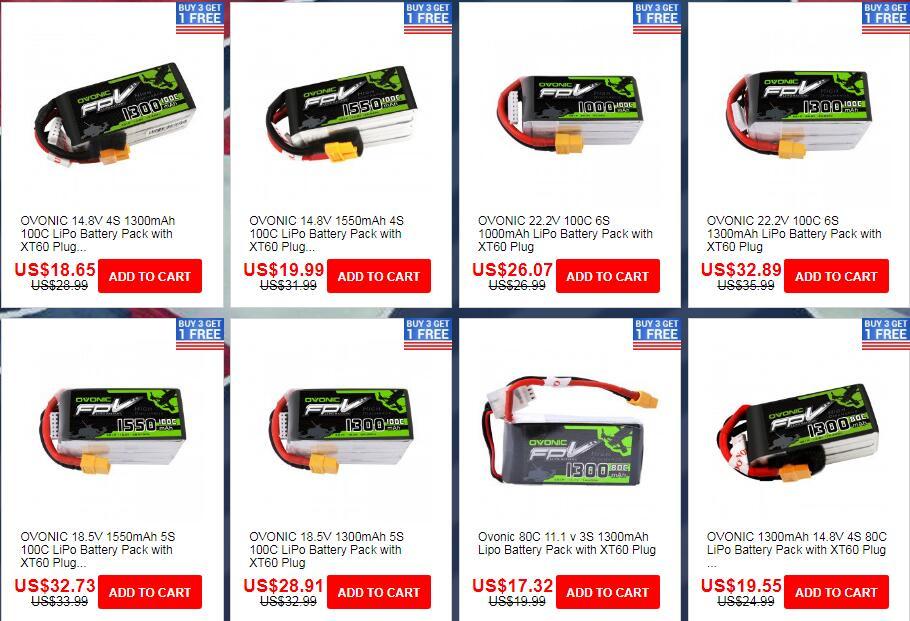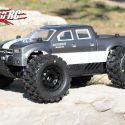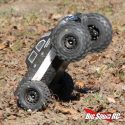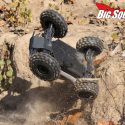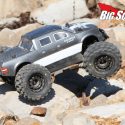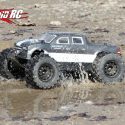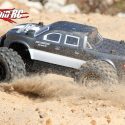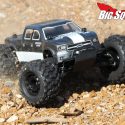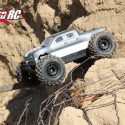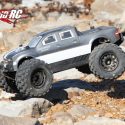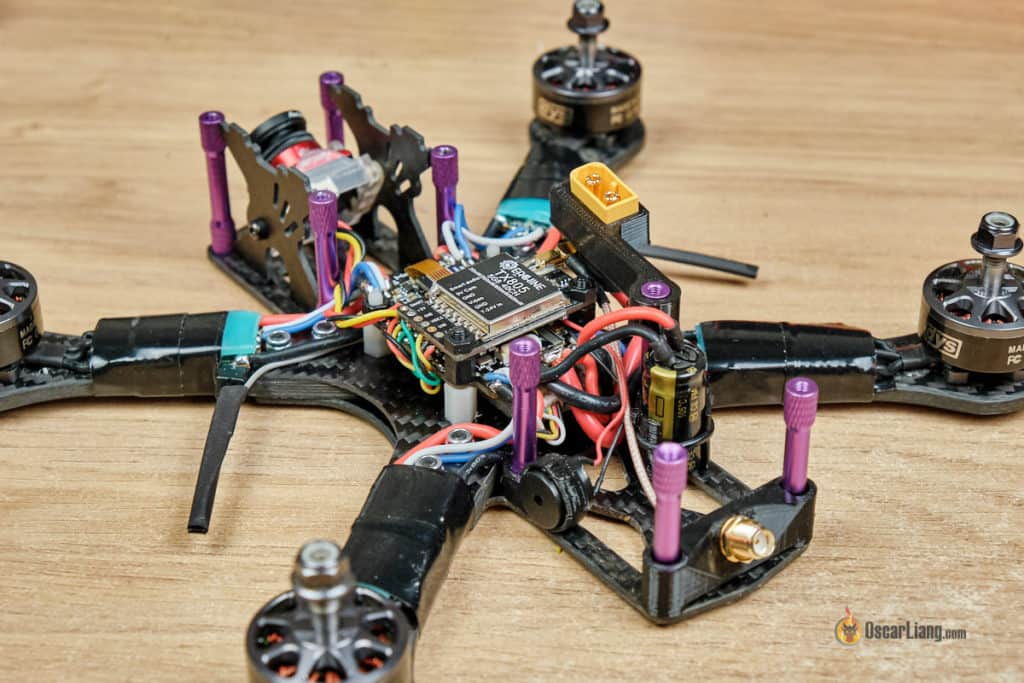A few years ago Pro-Line made huge news by releasing their very first truck, the PRO-2 SCT. Shortly on the heals of the PRO-2 was the PRO-MT, a truck that went on to become a Bash Vehicle Of The Year winner. Always a company to push the limits of technology, Pro-Line made huge news again this year with the announcement of their PRO-MT 4×4. While the 4×4 is sized much like the original 2WD PRO-MT, the 4×4’s all wheel drive system and stout looking parts are designed to take bashing to a new level. Did Pro-Line succeed? Is the PRO-MT 4×4 the best truck in its category? Is it a “works bike” level of rc truck? Keep on reading to find out…
From: Pro-Line Racing
Direct Link: PRO-MT 4×4 Monster Truck
Unboxing Pictures: BSRC Unboxes the PRO-MT 4×4
Review By: Cubby
Photography By: Tim Mohr
Specs:
RTR or Kit: Roller, assembled with no electronics
Age: 14+
2wd or 4wd: 4wd
Shaft or Belt: Shaft
Electric or Gas: Electric
Scale: 1/10
Length: 18″
Width: 14″
Wheelbase: 11.2″
Weight: 5.7lbs
Differential: 3 gear style diffs
Slipper Clutch: No
Driveshafts: Metal bones center, metal CVAs at the wheels
Shocks: Aluminum bodies, plastic caps, oil filled
Servo Saver: In steering rack
Screws: Metric, hex heads
Spur/Pinion Pitch: Mod 1
Bearings: Yes
Tires: Pro-Line Badlands MX28 tires, 17mm wheel hex
Battery: Not included
Part Number: #4005-00
Warranty: “Handled on a case by case basis”, contact Pro-Line customer service for more info
Bashing Specs:
Front wheel travel: 2.7″
Rear wheel travel: 2.7″
Wheelie on demand: Absolutely
Backflip off-ramps: Heck yea!
Stability Control: Up to you
Sound Module: Up to you
Self-Righting: It can by hitting the brake and gas
FPV: Up to you
Top Speed (measured by BSRC on
3S LiPo): 43 mph
Runtime (measured by BSRC on 3S MaxAmps LiPo): 18 minutes
Street Price:
$399
Primary Competition: Whoa, the PRO-MT 4×4 jumps into shark-filled waters in the 1/10th 4wd monster truck class. Some of the heavy hitters include the Traxxas Stampede 4×4 and the ARRMA Granite 4×4.
What’s Needed To Complete: The Pro-Line comes as a roller, so you’ll need a full set of electronics. You’ll need a transmitter, receiver, steering servo, speedo, motor,
batteries for truck and transmitter, a charger, and paint for the body. A pinion (with a sleeve) is supplied, as are three servo horns.
Build Quality: Our PRO-MT came in good shape. While ours was a pre-production unit, it was still built quite well.
Test Drivers: Iron “Full Throttle 24/7” Mikeee, Robbie Da’ Gangsta, Sam “I Hate Being Called A” Noobie, T-Mohr, Hawaiian Chris, and yours truly.
Test Venues: We got in a lot of trigger time with the PRO-MT. Speed runs were conducted in the parking lot of our local Costco. Trail, rock, and sand driving was done at Minnie Ha-Ha park in Fenton Missouri. We also busted out laps at the RC Outlaws 1/8th scale outdoor track in Collinsville Illinois.
Set-up Notes: So what did we used for electronics? We installed what we thought would be an uber set-up. For a transmitter, we used a new Futaba 7PX along with a Futaba R334SBS receiver. Steering was taken care of by a brushless Hitec 9360 servo. We serious power, a Castle Creations Mamba X speedo was used in conjunction with a sensor Castle 1415 2400kV brushless motor. MaxAmps supplied a 3S 5450 LiPo to power the truck and AA cells for the 7PX. Charging was handled by the easy to use Hitec RDX1. For paint, we used Duratrax gun metal and white.
Turning: With so many companies dialing a bunch of steering into their trucks nowadays, the PRO-MT 4×4 was much closer to neutral/slight understeer. Its slight amount of understeer going into corners made it easier to drive. At the apex, it felt very nicely balanced, with both ends sticking like glue (for a monster truck). Exiting a corner with the PRO-MT took a serious dose of self-control. Why is that? Because of it being a monster truck, giving too much throttle instant pulled the front wheels off the ground. It isn't rocketing science to know if the front wheels aren’t touching, they aren’t steering either. However, when we gave the truck a moderate dose of throttle the front remained steady and did a mighty fine job of pulling the truck out of corners like a miniature rocket.
Jumping: We found the PRO-MT 4×4 to be excellent in the air. While some 4×4 monster trucks are too sensitive to corrective trigger inputs while airborne, the PRO-MT was not. This was thanks to its center differential. If you needed to drop the nose just a touch, a brief tap of the brake seemed to work perfectly. Some other trucks (those without a center diff) would totally endo-out with the same amount of input. Being so easy to jump helps the PRO-MT to give its driver confidence. We found ourselves hitting all sorts of crazy jumps. From back-flipping off of curbs, to giant 30-foot tall cliff jumps, we felt like no matter what we hucked it off of, that we could land it. The center diff helped, but so did its suspension settings and general suspension geometry. Both were excellent and provided clean, straight, take offs from most ramps. Its suspension also did an excellent job of soaking up big landings, even hard ones to the pavement that would bottom other trucks out like crazy.
Bumps/Whoops: When flying through the all-sorts-of-ugly that we like to blast through, the Pro-Line proved to be one of the most capable trucks we’ve ever tested, regardless of scale. Yes, at warp 9.2 totally WFO, the rear would occasionally kick, typically straight up, when coming off the gas in the rough. Otherwise, if you kept on the throttle, it would absolutely pound through the rough stuff. Hard on the gas, the truck would tend to raise in the front. This helped the leading edge of the truck float simply over rough patches, just leaving the rear to really slam into the rut or whoop. The weight bias of the truck favored fast rough stretches, just like its rear shock settings. Truly, we found the Pro-Line to be an amazing truck over whoops, rain ruts, and even over sticks/rocks/dirt clods on a trail.
On-Road: We didn’t do as much pavement driving with the Pro-Line as we do most test trucks, but that was because we were always itching to keep driving it on dirt. Still, we managed to drain two packs on-road and found the PRO-MT to be what it really is, a monster truck designed for off-road driving. No, the PRO-MT wasn’t bad on-road, but it drove like you would expect, it traction rolled when hitting corners too fast and always had its nose in the air when pounding the throttle.
Grass: As you will read directly below in the “tires” portion of our review, those wonderful Badlands MX28 tires do a great job in the grass. In fact, they are probably the best tires that money can buy for grass driving. Those tires, combined with a more than capable chassis and 4wd driveline, allow the PRO-MT 4×4 to be top notch in the grass. The tires provide loads of forwarding and side bite, chewing through grassy like a champ. We know a whole lot of you bashers only drive on grass, if that is your M.O., the PRO-MT 4×4 is easily one of the best trucks you can buy.
Tires: Years ago in a face-to-face meeting that we had with Pro-Line, they asked us if there was anything that we would like to see them make. One of our many answers was “fully licensed motocross tires, but for RC trucks”. While the MX28 tires are not licensed by one of the motocross tire companies, they do sport a full-on motocross tread pattern. Motocross bikes have been using that style of knobby tires for decades, and guess what? Yup, they work equally well on an rc truck. Now, most bash trucks came with decent tires. Tires that don’t wear out too quickly, yet get a reasonable grip on a wide variety of surfaces. Pro-Line is much different. It comes out of the box sporting the Best off-road bashing tires that money can buy. The MX28s are simply outstanding on loose/loamy/clod-filled dirt, gravel, and grass. They provide more traction than any other tire you can buy, therefore giving the PRO-MT 4×4 a huge advantage over other trucks in its category. Ya, you might change the tires later on if you specifically drive on pavement or sand. Otherwise, unless you wear the MX28s out, you can count on them being the best shoes in the business for a bash truck.
Power: No, the Pro-Line doesn’t come with a power system, but we would like to mention the system we installed. The PRO-MT allows you to mount up a wide variety of power systems. If you have a 550 size short course truck system laying around, it will work. If you have a system for a 1/8th scale buggy/truggy, that works too. We went with a Mamba X and 1415 as we felt it was more than enough raw wattage for a truck the size of the PRO-MT 4×4, and we knew it would run cool and last a long time. That system was sensored, so even throttle precision from a dead stop was top notch. Sure, some of you guys might bolt in full 1/8th scale power systems, but that really is overkill. Also, we only used 3S in our test truck. Even at that cell count, we knew we would have insane power and the Castle system did not disappoint. 1415 absolutely loves being run on 3S and it did a fantastic job of powering the truck.
Radio: The Pro-Line doesn’t come with a transmitter either, but because we are simultaneously working on the Futaba 7PX review, that’s what we installed. Needless to really say, the 7PX is the absolute BOMB and was a perfect match for a high-end bash truck like the PRO-MT 4×4.
Broken Parts: What did we bust up on our review truck? While we did have a couple of little pre-production issues on our test unit, overall it held up well. We never broke an arm or tower, and all three diffs are still alive and well. After bashing the truck properly, like the BSRC Bash Crew knows how to do, it did finally stop running after one of the plastic inserts on the front pillow balls melted and caused one of the front wheels to stop turning. Otherwise, our test truck has taken a ridiculous beating and kept on ticking.
Misc Notes:
Oh yes, we love our miscellaneous notes here at BSRC. LOL. We are going to start off with the bumpers. Both were extremely well designed with crush zones, this allows them to actually help soak up a hit without any parts breakage.
You’ll notice when taking a look around the PRO-MT 4×4 that there are lock nuts everywhere. That is not only awesome but also helps keep the truck together, even under extreme usage.
Is the design and build quality a “step up” from the other brands? In our opinion, the answer is yes. From the tip of the front bumper to the end of the rear, every part looks to have been designed with extreme bashing in mind. Of course, you can break any truck if you hit something hard enough, but it appears that the design team went to great lengths to provide plenty of beef on the PRO-MT 4×4. The aluminum parts like the shock bodies, chassis, and motor mount, were also well done, just like the plastic parts.
While we didn’t have any issues with the plastic shock caps, we would rather have seen them made from aluminum. As most of you guys already know, plastic caps can be a nightmare, thankfully that hasn’t been the case so far with the Pro-Line.
We had the rear sway bar pop off one of the rear arms. As ours was a pre-pro unit, we got with Pro-Line and they recommended moving the pivot ball 2mm further out on the sway bar and that solution worked well for us.
The PRO-MT 4×4 comes with beefy 17mm wheel hexes. That is a great thing for durability but prevents you from mounting up wheels with a standard sized hex (12mm). No need to worry though as Pro-Line has already produced plenty of wheels with a 17mm hex to fit the 1/10th scaled PRO-MT 4×4.
We were fans of the motor mount, but not the way it mounted. The Pro-Line unit works fine, and is actually really awesome when used with a 1415 because it also supports the rear of the motor (but the support must be removed if you install a 1/8 sized unit). However, its downside has to do with its mounting screws. The motor mount uses small spacers to determine the gear mesh. If you are super organized you will be fine, but we have already lost most of the gear mesh/motor mount spacers in our giant mess of a toolbox.
Those shocks! Wow, we were very impressed with the action of the shocks on the truck. Initially, we thought they would be too soft for the power system that we installed, but that was not the case. With our Mamba X/1415/3S system, the truck was sprung and damped quite well. The shocks were soft enough to swallow small bumps with ease and to provide loads of traction on loose surfaces, yet they were stiff enough to pound through whoops and not bottom too hard on big jump landings. Very impressive.
As always, we were huge fans of the Pro-Line Secure-Loc body mount screws. These are a zillion times better than body clips for both ease of use and for not getting lost.
What was it really like driving the PRO-MT 4×4? Well, yes, it was a bit like having a full factory works bike in our hands. It just seemed like the suspension worked better than most other brands. It also seemed like it cornered better, and it just felt smoother than most other brands. Smooth, precise, and confidence inspiring, that is how we would best describe driving the PRO-MT 4×4.
Our test crew really like the Sentinel body. It has a tough, proper look for a truck like the Pro-Line.
We are big fans of rollers here at BigSquidRC. Why? Because, just like many of you, we have a zillion electronics laying around the office. Why pay for RTR electronics when most experienced hobbyists are most likely going to ditch them anyway?
The servo saver on our truck came too tight. We loosened it up 2 full turns and now it works much better.
At 2.7″ front and rear, the Pro-Line has a LOT of suspension travel. This allows the truck to tackle rough sections, or big jump landings, like a champ.
Much like the 2WD PRO-MT, the 4×4 comes with tall side guards to keep dirt/junk/rocks/sticks out of the chassis area. We found that the guards actually worked quite well. No, they didn’t keep everything out, but they did help keep a lot of extra dirt out of the chassis area.

